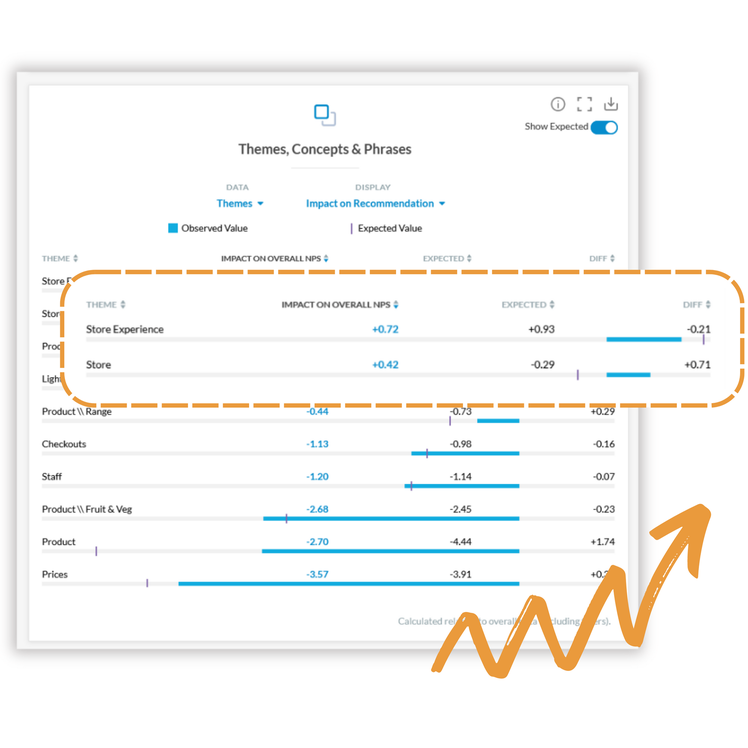Have you ever stubbed your toe more than once on a piece of furniture?
The furniture may have been there forever. It can’t move on its own and you know it’s causing you pain, so why don’t you just move it?
Pain is an interesting topic. As humans, we avoid pain as much as possible. But we also understand that sometimes, pain seems inevitable.
When you’re thinking about your customer experience (CX), one of the best ways to improve your CX is to find and eliminate customer pain points. To make life easier for your customers. There’s no better way to accomplish this than to leverage customer insights.
By collecting the right data, asking the right questions, and uncovering clear insights, you can identify which “furniture” needs to be moved so your customers aren’t repeatedly stubbing their toes when interacting with your brand and product.
What are customer insights?
Customer insights are your interpretations of your customer’s behaviors, needs, and preferences. You get to customer insights by collecting and analyzing customer feedback and data from many sources, including:
Feedback that you receive through direct contact with customers, such as support tickets or call recordings.
Collecting feedback through surveys, like a post-purchase NPS survey or a post-support interaction CSAT survey.
Scouring the internet to see what clients/customers/consumers are saying about your brand (hello Reddit, thank you!).
By the way, this is relevant in any industry: SaaS, D2C, hospitality, and more. We even broke down how to leverage customer insights in the banking industry. If there’s a product or a service, there’s a customer. And if there’s a customer, they have opinions, meaning you can find valuable insights when you’re willing to do the work.
How to find the right data to surface insights
Have you ever been to a restaurant that has too much to choose from on the menu?
You sit there and ponder it. Your waiter stops by several times, but you’re never ready. By the time you get through the menu, you’re frustrated and hangry. You don’t even REALLY know what you just read because you were skimming it, waiting for the right meal to jump out at you.
Maybe I’m using that analogy because I just went to a restaurant like that and needed to vent about it, but I think this is how data collection and analysis often feels. Many companies already have a wealth of data, and zeroing in on what will help generate actionable insights is hard.
There’s a lot of data out there, and it can all feel overwhelming. How are you supposed to identify pain points when you don’t even know where to look?
If that resonates, start by looking for relevant data from across your customer journey. Look for the what—such as “How satisfied are customers with our support?”—but then dive deeper to uncover the why.
Customer insights tell you why your customers act the way they do. That’s where you’ll find their pain points.
Moving from insights to pain points
Now that you have insights into your customers’ feelings and experiences, what do you do with them?
Your gut reaction will probably be to start by understanding what makes your customers happy. That’s fine! Take that, celebrate a little, and pat yourself on the back. But then set that aside, because we’re here to talk about what’s causing your customers pain.
No, not physical pain (well, maybe? Guess it depends on what you’re selling or making).
Here are four questions to ask yourself to uncover customer pain points:
What’s driving people to give poor Net Promoter Scores (NPS)? A low NPS score means you may have some bad word of mouth. Where are people talking smack about you? What are their biggest complaints?
What’s causing people to leave? Why are your customers churning or opting to purchase elsewhere? What are they using instead of your product? What’s better about that alternative?
What do your customers want next? Our attention span is 8 seconds (that’s less than a goldfish), meaning your customers are going to get bored if you let them. If they see something nice and shiny, they’re going to grab it. When customers sign up for your product, where are there gaps where you can proactively guide them towards success?
What are the top reasons for negative or neutral reviews? Look at both product reviews and surveys like CSAT.
There are plenty of other questions you can ask too—the point is to use questions to understand your customers more deeply.
We started with customer data, figured out how to move deeper into insights, and used those to uncover specific pain points. Now, my friends, is the FUN part.
The part that actually makes a difference.
This is how we change the game to make happy users and customers who keep coming back for more.
Prioritize your (customers’) pain
The pain points you’ve uncovered can be prioritized in many ways. Everyone you ask will have a different opinion.
Ask your Chief Marketing Officer (CMO) what’s the top priority, and they might tell you to do EVERYTHING you can to increase NPS and five-star reviews. Protect and improve the brand image at all costs.
Ask your Chief Finance Officer (CFO) which is the most important pain point to focus on, and they’re going to tell you it’s the one with the biggest dollar sign attached. It may be something about decreasing conversion rates, it might be related to lowering churn, or maybe it’s about increasing margin. Doesn’t matter what it is, just find the biggest dollar sign and fix that first.
This is where a customer feedback analytics tool can really help. It’s valuable to get input from your organization, but an analytics tool gives you an unbiased approach to understanding what actions are most likely to have the biggest impact on your customer experience.
If you’re a CX leader, you’ve got a ton of power here.
You get to help shape and influence what’s seen as the highest priority because you can analyze the big picture—the whole customer experience. As the team responsible for advocating for your customers’ best interests, you can help your organization stay focused on what’s best for your users (because that’s ultimately what’s best for the whole business).
Once you’ve made a prioritized list of pain points, it’s time to take action. Define your KPIs and how you’ll measure success ahead of time, and don’t forget to take notes and track progress along the way. Everyone loves a good before-and-after story!
The *magic* feedback loop
Now, I have some bad news. You may want to sit down for this one.
There will always be new customer pain points. Not only that. The bigger your business grows, the harder it gets to communicate and take action that solves meaningful pain points.
I know, I know. That’s hard to hear. Take a deep breath, it will be okay—I promise.
A tool like Kapiche makes it easy for you to continually stay on top of existing and emerging trends in your customer feedback.
To continue to get through pain points (new and old) you’re going to need a sturdy foundation and a continuous loop of information. This ensures issues get bubbled up so they can be fixed, and helps you keep everyone on the same page.
Here are 3 tips to create a healthy feedback loop.
Create one-on-one, recurring meetings with key stakeholders. Come prepared for these meetings with the insights you’ve gathered from your customer feedback analytics tool. If you’re able to, try creating a self-service insights engine so that everyone across your organization can better understand your customers.
Change one variable at a time. Solving one pain point at a time can help you track the impact of your actions. Consistent changes over time add up to a transformation of your entire customer experience.
Make a point to share success stories. Success stories are great for a million reasons. Share success companywide and give credit where credit is due. This motivates your team, keeps your CX in the limelight, and should help you secure additional investments in CX in the future. And honestly, everyone just loves some healthy, well-deserved praise! Keep the good vibes going.
Your customers notice when you solve their pain points
As your products or services evolve, you’ll constantly come up against new customer pain points. On top of that, your customers’ needs and expectations are always changing, so you can’t ever fall asleep or take your hands off the wheel.
That might seem frustrating, but it’s also part of the fun of working to build incredible customer experiences. Each time you can identify and solve a customer pain point, your customers will trust your brand more and be more likely to come back and purchase again. Who knows—they might even tell their friends!
That’s the power of using insights to solve pain points. If you’re struggling to make sense of your customer data and to turn insights into action, check out a demo of Kapiche today.






